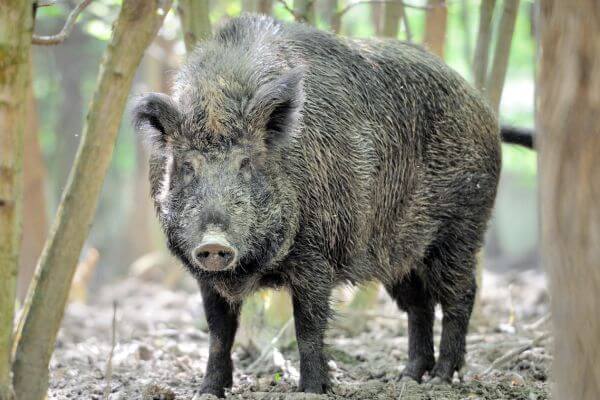Wild boars, also known as wild pigs, are native to Europe, Asia and Africa, but have been introduced to many other parts of the world over the centuries. Although they have been introduced into many regions as a food source and for hunting entertainment, the lack of natural predators in these regions has led to a population explosion that poses a significant threat to biodiversity and local agriculture.
In this article, we will explore the history of wild boar introduction, the reasons behind it, and the negative impacts of the invasive species on natural environments and crops. We will also discuss ongoing efforts to control wild boar populations around the world.

How did the introduction of the wild boar occur in different parts of the world?
Historical records show that wild boars were introduced to the Americas by early European settlers as a source of food and for hunting entertainment. Some records indicate that it was also introduced to Australia and New Zealand in the 19th century, while further introductions have been made to South America, South Africa and some Pacific islands.
In addition, there are reports that the wild pig was introduced in several other regions of the world, often with the aim of expanding hunting activity or for meat consumption. Over time, the population of these animals has grown exponentially in many regions, becoming an invasive species that causes environmental and economic problems, since it has no natural predators and is not subject to the same factors that control the population in its habitat. native.
This can lead to significant impacts on local biodiversity, with the wild boar competing with other species for resources and causing damage to agricultural crops. As it is a generalist species, it easily adapts to different habitats and is able to reproduce quickly, which can lead to a rapid population increase and competition with other native species.
What are the reasons behind the introduction of wild boars in different regions?
The introduction of the wild boar into new regions has generally been driven by a variety of factors, including sport hunting, the creation of new food sources, and the accidental introduction of farm animals. In North America, for example, it was introduced initially as a hunting species for European settlers and later to improve hunting opportunities for sportsmen.
In Australia, it was introduced to provide an alternative source of meat for settlers and later for sport hunting. In South Africa, wild boar was introduced for hunting, but it also became an important source of meat for settlers. In Brazil, it occurred during the colonial period, when the Portuguese brought animals from other parts of the world to the country as a way to obtain food resources and meet the demands of economic activities at the time.
Wild boar, which is known to be a rich source of protein, was brought to Brazil as a meat option for colonists and slaves. In addition, the Portuguese also introduced the animal for hunting, a very common leisure activity in Europe that was soon adopted in Brazil. Since then, the wild boar has spread across the country and has become an invasive species, causing environmental and economic problems.
How did this invasive species adapt to the new environments?
The wild boar is a highly adaptable animal and can thrive in a variety of environments. When introduced to new regions, they are usually able to find plentiful food sources, including roots, tubers, fruits, and even small animals.
As they have few natural predators in many of these environments, they are able to reproduce quickly and expand their populations. In addition, it is a highly intelligent animal and can quickly adapt to changes in environmental conditions. As a result, it is able to thrive in many environments and become an invasive species in areas where it is not native.
This adaptability can allow them to become a significant threat to local biodiversity, competing with other species for resources and even preying on native species. They can also cause significant damage to agricultural and forestry crops, as well as increase the risk of disease transmission.
What are the negative impacts of this invasion and what efforts to control populations?
The presence of invasive wild boars can have a significant impact on local biodiversity, as they can compete for resources with other native species and even feed on native species. In addition, they can cause significant damage to agricultural and forestry crops, foraging and damaging plants and even razing entire areas of plantations.
They can also increase the risk of transmitting diseases such as African swine fever, which can affect both wild boar and domestic pigs. Various methods are used to control invasive wild boar populations, including sport hunting, trapping, birth control, and specialized hunting dogs. In many countries, hunting is an important tool for controlling invasive wild boar populations.
While other techniques, such as the use of traps, have been increasingly used to capture and remove these animals from areas where they cause significant damage. Birth control, which involves using contraceptive drugs on female boars, is another technique that has been used successfully in some areas.
The future of wild boar in different regions of the world
While efforts to control invasive wild boar populations have been successful in many areas, the threat they pose to local biodiversity and agricultural crops remains a significant challenge worldwide. As the human population grows and the global climate changes, it is possible that the presence of invasive wild boar will become even more problematic in some regions.
In the future, it may be necessary to consider other solutions, such as creating habitat management programs, more strictly controlling the introduction of wild boar into new areas, and developing new population control techniques to deal with this constantly evolving invasive species. . Ultimately, wild boar is an invasive species, and must be carefully considered and regulated to protect the environment and native species.
If the wild boar invasion is not controlled in the world, the population of these animals could continue to grow uncontrollably, causing even greater damage to biodiversity and local agriculture. In addition, they can become an even greater threat to public health, as they are known to be carriers of various diseases that can affect humans and domestic animals.
The increased interaction between humans and wild boars can lead to conflicts and even serious accidents, such as being run over on highways. For these reasons, it is important that measures are taken to control the wild boar population and prevent its further expansion in the future.

